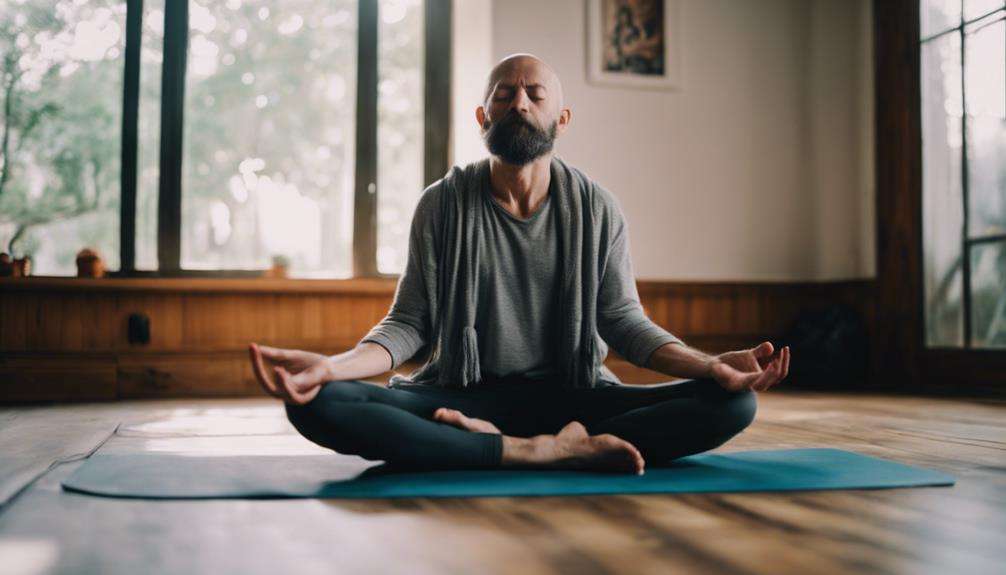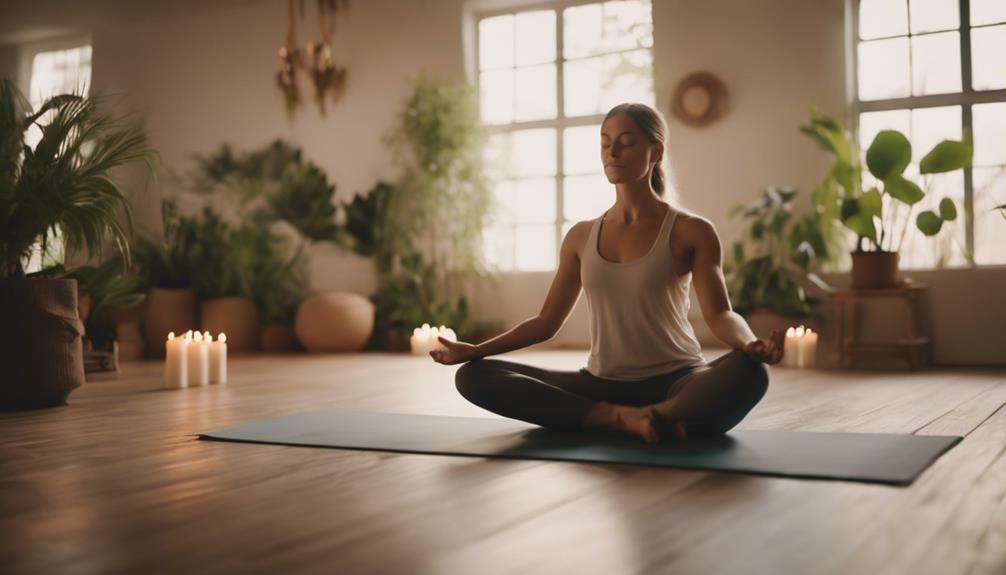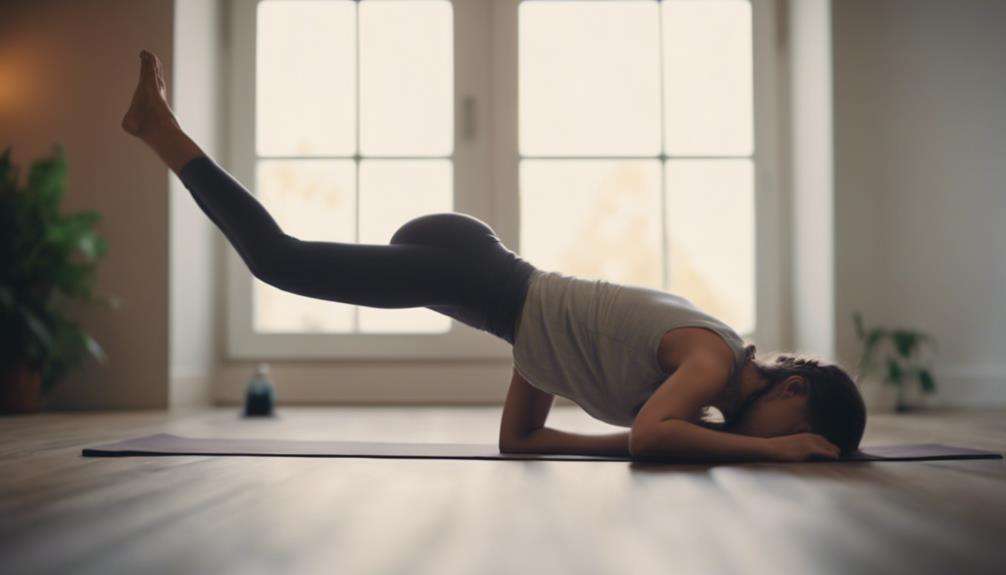When stress weighs heavy on your shoulders, the answer might just be in something as simple as your breath. Take a moment to consider this: What if the key to unlocking relaxation and serenity lies within the way you breathe?
Intriguing, isn't it? The best breathing exercises for stress offer a gateway to calmness and mental clarity, providing a pathway to a more balanced and centered state of being. Explore these techniques further and discover how a few intentional breaths could transform your day-to-day experience.
Key Takeaways
- Deep breathing techniques like diaphragmatic breathing counteract stress-induced shallow chest breathing.
- Breath focus exercises help disengage from distractions and effectively control breathing patterns for relaxation.
- Equal time breathing technique promotes mindfulness and relaxation by inhaling and exhaling to a specific count.
- Progressive muscle relaxation reduces physical tension and promotes calmness by systematically tensing and releasing muscle groups.
Deep Breathing Techniques
When practicing deep breathing techniques for stress relief, focus on inhaling deeply through your nose and allowing your belly to expand with each breath. This type of breathing, also known as diaphragmatic breathing or abdominal breathing, involves drawing air into your lungs deeply, which can help activate the body's relaxation response.
By engaging in deep breaths that originate from your diaphragm, you can counter the shallow chest breathing often associated with stress and anxiety. Placing one hand on your belly and another on your chest can assist you in monitoring your breath, ensuring that your abdomen rises and falls with each inhalation and exhalation.
Controlled breathing is a fundamental part of relaxation techniques. It helps quell errant thoughts, reduce tension, and promote a sense of calm. Whether you're lying down comfortably or sitting with support, incorporating deep breathing into your daily routine can enhance your overall well-being.
Breath Focus Exercises
To deepen your stress relief practice, transition from deep breathing techniques to Breath Focus Exercises, which involve concentrating on slow, deep breathing to disengage from distractions and promote relaxation. When practicing breath focus exercises, you can:
- Control your breathing patterns effectively to calm your mind and body.
- Find a quiet place where you can focus solely on your breath and relaxation.
- Use helpful imagery or a focus word to enhance the relaxation response.
These techniques are particularly helpful for individuals experiencing anxiety and stress, as they aid in reducing tension in the stomach and disengaging from distracting thoughts.
By incorporating breath focus exercises into your daily routine, you can elicit the relaxation response more efficiently, ultimately diminishing the impact of stress on both your physical and mental well-being.
Equal Time Breathing Technique
Implement the Equal Time Breathing Technique by focusing on inhaling and exhaling to a specific count, starting with five and gradually increasing for improved mental well-being. This breathing exercise aims to create a balance between inhaling and exhaling, promoting relaxation and mindfulness.
By practicing Equal Time Breathing, you can effectively reduce stress levels and enhance concentration. To begin, find a comfortable seated position with a straight back to allow for optimal airflow. Start by inhaling for a count of five and then exhaling for the same count.
As you become more accustomed to this technique, gradually increase the count to deepen the relaxation effect. This method not only helps in calming the mind but also in fostering a sense of inner peace.
Progressive Muscle Relaxation
Progressive Muscle Relaxation involves systematically tensing and releasing muscle groups to induce deep relaxation and reduce physical tension. This technique is an effective way to unwind and promote overall well-being.
Here are three key points to help you understand the benefits of Progressive Muscle Relaxation:
- Muscle Groups: By focusing on different muscle groups, starting typically from the feet and moving upwards, you can release tension systematically throughout your body.
- Tension Reduction: Through the process of tensing muscles while inhaling and then releasing the tension while exhaling, you can effectively reduce physical tension.
- Calmness and Relaxation: Progressive Muscle Relaxation helps in promoting a sense of calmness and relaxation, making it a valuable tool in managing stress.
Incorporating Progressive Muscle Relaxation into your routine can significantly impact your well-being by providing a method to alleviate stress and induce a state of tranquility. Practice this technique regularly to experience its full benefits.
Modified Lions Breath Exercise

Engage in the invigorating Modified Lions Breath Exercise to enhance facial muscle vitality and alleviate stress effectively. This yoga-inspired technique involves sitting comfortably and taking a deep breath through your nose, allowing your chest to expand fully. As you exhale, produce a loud 'HA' sound while visualizing the release of breath like a lion. Repeat this exercise several times to help release tension and promote relaxation.
The Modified Lions Breath Exercise is a simple yet powerful method for calming both the mind and body. By focusing on your breath and the deliberate exhalation, you can feel the stress melting away. This exercise not only energizes your facial muscles but also aids in achieving a sense of calm and tranquility.
Incorporating this technique into your Relaxation Techniques routine can help you combat stress and foster a deep sense of relaxation. Try the Modified Lions Breath Exercise whenever you need a quick and effective way to unwind and find inner peace.
Frequently Asked Questions
What Is the Best Breathing Pattern to Reduce Stress?
For reducing stress, the best breathing pattern is deep diaphragmatic breathing. Engage your diaphragm fully by focusing on expanding your chest and abdomen. Practice abdominal breathing in a calm environment for 10-20 minutes to effectively alleviate stress.
What Breathing Technique Is Best for Anxiety?
When facing anxiety, diaphragmatic breathing shines as the go-to technique. Engaging the diaphragm, it aids in stress reduction and induces relaxation. Have you tried it? Your cortisol levels can thank you later.
What Is the Most Effective Breathing Exercise?
For effective stress relief, diaphragmatic breathing stands out. When you breathe deeply into your diaphragm, your body's relaxation response kicks in. Lowering heart rate and blood pressure, this technique helps reduce stress, anxiety, and promotes calmness.
Do Breathing Exercises Work for Stress?
Breathing exercises are effective for stress relief, promoting mental calmness. They engage the relaxation response, encouraging diaphragmatic breathing and emotional regulation. Mindful deep breaths foster the mind-body connection, shifting from fight or flight to relaxation.
Conclusion
In conclusion, incorporating breathing exercises into your daily routine can greatly benefit your mental well-being and overall health.
By practicing deep breathing, breath focus, equal time breathing, progressive muscle relaxation, and the modified Lions Breath technique, you can effectively manage stress, promote relaxation, and improve your cardiovascular function.
Remember, taking a few moments each day to focus on your breath can have a profound impact on your well-being.
So take a deep breath, relax, and enjoy the benefits of these powerful techniques.






